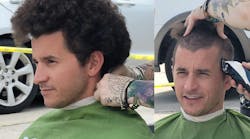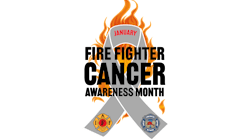May is Skin Cancer Awareness Month. How can a fire department raise skin cancer awareness and create a free skin cancer screening event for its members? It can utilize partnerships with the Firefighter Cancer Support Network (FCSN) and the American Academy of Dermatology (AAD).
Increased rates
Studies have concluded that, compared with the general population, firefighters have a 21 percent greater risk of melanoma, which is the most serious form of skin cancer. Firefighters who are between the ages of 30–49 have a 62 percent greater risk of melanoma.
These increased rates are because firefighters are exposed to cancer-causing substances while they fight fires. Dermal absorption occurs because of either permeation or penetration of fireground contaminants through a member’s gear or because of the transfer of contaminants from the gear to the skin.
The fire service’s best practices to combat and reduce the occurrences of skin cancer include showering after a fire, cleaning contaminated bunker gear, wearing sunscreen and having an annual head-to-toe skin examination. Early detection is key, because skin cancer is highly treatable when it’s detected early.
Organizational, individual barriers
The vast majority of firefighters don’t get their skin checked annually nor have an annual physical exam with a primary care physician (PCP). According to Kepra Jack of HeartFit for Duty, only 22 percent of firefighters have a PCP who they see regularly. Why is this? Organizational and individual barriers. Organizational barriers include departments not providing their membership with an annual medical exam. Individual barriers include the inability of members to afford medical insurance and copays or simply not wanting to wait weeks or months for an appointment. These barriers prevent implementing practices to prevent/reduce their chances of skin cancer.
FDNY confronted these barriers by partnering with FCSN and AAD to provide its membership with free quarterly skin cancer screenings.
Since its first screening event on Sept. 30, 2023, FDNY and its partners have provided free screenings to more than 300 FDNY firefighters. During these screenings, 78 potential or suspected cancers were found.
The success of these events demonstrates that every type of fire department, be it large or small, career or volunteer, can mirror what FDNY has done.
Lessons learned
From multiple events, FDNY learned a few lessons.
Is the screening really free? This question often is asked by both members and leadership. Besides departments providing a location, yes, it’s free. Dermatologists volunteer their time.
Location, location, location. Provide firefighters with an easy and convenient location. FDNY chose to use its fire academy for its screenings, because it’s centrally located and ample parking. However, screenings can take place in firehouses or union halls. Only one clean private room is needed for individuals to be screened.
Screenings on weekends is preferred. The weekend works better for the volunteer dermatologists.
Ease members’ fears of screening by describing a typical screening. Most firefighters never had a skin cancer screening and are unaware of what happens during one. Describe in communications with the membership what happens during a typical skin cancer screening. A firefighter fills out a form that asks questions about family history and areas of concern and then enters a private room with a dermatologist, who goes over the paperwork and conducts the screening. Anything noteworthy is recorded, and firefighters are instructed to follow up with their own dermatologist.
Stress that records and other information aren’t shared with the department.
The process lasts only 10 minutes.
Scheduling made easy. A sign-up website was opened by FDNY about a month before events. This allowed members to choose a convenient time. It also allowed event planners to book and space out dermatologists. FDNY encouraged its members to book an appointment but didn’t turn away walk-ins.
Boosting turnout. Multiple methods that increase participation include internal department memos, distributing firehouse posters, emailing all fire company units—particularly ones scheduled to attend training at the academy (location of screening)—sending reminder emails via FCSN, and having unions release safety messages.
During sign-ups and all communications to members, a feedback loop was given. (In FDNY’s case, my contact information was listed.) This provided members who were experiencing any problems with sign-ups or who had general questions with a method to communicate.
Increasing accessibility to on-duty personnel. Departments can decide to have fire companies dispatched to the screening location. FDNY chose to allow companies to choose whether to receive a dispatch ticket to be sent to the event.
Having help. Assign a department contact person to assist the dermatologist with any unforeseen necessities or problems.
Have an after-action review. After the event, an after-action review meeting between key players and participants can lead to ways to improve the next event.
Look out for each other
Throughout our career as a firefighter, we train to protect life, particularly the lives of our brothers and sisters. However, saving a brother or sister doesn’t just mean dragging them out of a burning building. It could be as simple as telling someone to take a shower after a fire or helping to implement a quarterly skin cancer screening. Even if we only save one life, it will be worth it all.
PRODUCT SPOTLIGHT
Decontamination Washer
The Solo Rescue decon washer from RESCUE Intellitech is an essential part of every modern fire department’s decontamination process. It’s compliant with NFPA 1851: Standard on Selection, Care, and Maintenance of Protective Ensembles for Structural Fire Fighting and Proximity Fire Fighting and NFPA 1852: Standard on Selection, Care, and Maintenance of Open-Circuit Self-Contained Breathing Apparatus (SCBA). It reduces carcinogenic polycyclic aromatic hydrocarbons (PAHs) and minimizes exposure and risk to cross-contamination.
Cancer Prevention Training
According to the American Academy of Dermatology, firefighters who are between the ages of 30-49 have a 62 percent greater risk of melanoma. Learn how your firefighter training program can benefit from this free melanoma/skin cancer prevention initiative that was developed by Mollie’s Fund. Since its inception with the FDNY, firefighter communities across the nation have included this life-saving initiative into their curriculums.
Fireground Contaminant Removal
Firewipes remove soot, smoke and other potential fireground contaminants. They are 8 x 12-inch, biodegradable, industrial-strength, disposable wipes that are infused with cleansing compounds for use on all external dermal areas. Firewipes are saturated with a specific formula to minimize additional exposure through dermal absorption.









